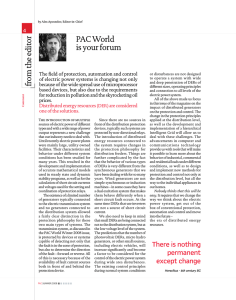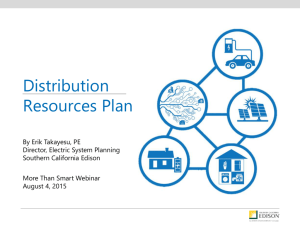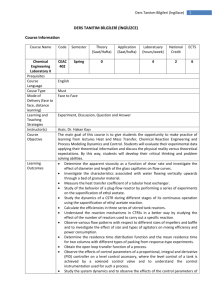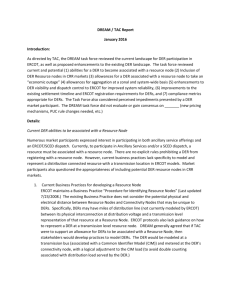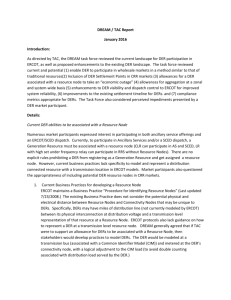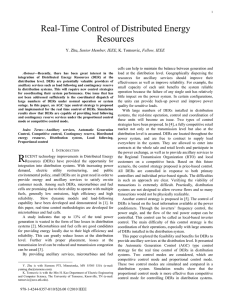Optimal distribution power flow for systems with distributed energy resources
advertisement
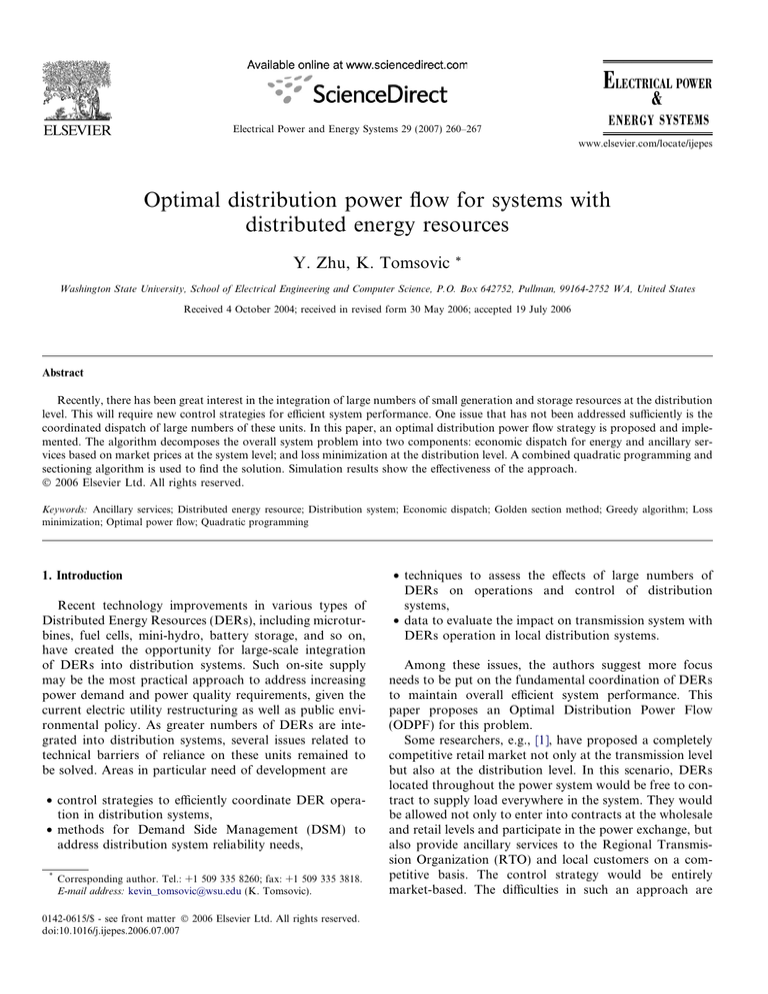
Electrical Power and Energy Systems 29 (2007) 260–267 www.elsevier.com/locate/ijepes Optimal distribution power flow for systems with distributed energy resources Y. Zhu, K. Tomsovic * Washington State University, School of Electrical Engineering and Computer Science, P.O. Box 642752, Pullman, 99164-2752 WA, United States Received 4 October 2004; received in revised form 30 May 2006; accepted 19 July 2006 Abstract Recently, there has been great interest in the integration of large numbers of small generation and storage resources at the distribution level. This will require new control strategies for efficient system performance. One issue that has not been addressed sufficiently is the coordinated dispatch of large numbers of these units. In this paper, an optimal distribution power flow strategy is proposed and implemented. The algorithm decomposes the overall system problem into two components: economic dispatch for energy and ancillary services based on market prices at the system level; and loss minimization at the distribution level. A combined quadratic programming and sectioning algorithm is used to find the solution. Simulation results show the effectiveness of the approach. 2006 Elsevier Ltd. All rights reserved. Keywords: Ancillary services; Distributed energy resource; Distribution system; Economic dispatch; Golden section method; Greedy algorithm; Loss minimization; Optimal power flow; Quadratic programming 1. Introduction Recent technology improvements in various types of Distributed Energy Resources (DERs), including microturbines, fuel cells, mini-hydro, battery storage, and so on, have created the opportunity for large-scale integration of DERs into distribution systems. Such on-site supply may be the most practical approach to address increasing power demand and power quality requirements, given the current electric utility restructuring as well as public environmental policy. As greater numbers of DERs are integrated into distribution systems, several issues related to technical barriers of reliance on these units remained to be solved. Areas in particular need of development are • control strategies to efficiently coordinate DER operation in distribution systems, • methods for Demand Side Management (DSM) to address distribution system reliability needs, * Corresponding author. Tel.: +1 509 335 8260; fax: +1 509 335 3818. E-mail address: kevin_tomsovic@wsu.edu (K. Tomsovic). 0142-0615/$ - see front matter 2006 Elsevier Ltd. All rights reserved. doi:10.1016/j.ijepes.2006.07.007 • techniques to assess the effects of large numbers of DERs on operations and control of distribution systems, • data to evaluate the impact on transmission system with DERs operation in local distribution systems. Among these issues, the authors suggest more focus needs to be put on the fundamental coordination of DERs to maintain overall efficient system performance. This paper proposes an Optimal Distribution Power Flow (ODPF) for this problem. Some researchers, e.g., [1], have proposed a completely competitive retail market not only at the transmission level but also at the distribution level. In this scenario, DERs located throughout the power system would be free to contract to supply load everywhere in the system. They would be allowed not only to enter into contracts at the wholesale and retail levels and participate in the power exchange, but also provide ancillary services to the Regional Transmission Organization (RTO) and local customers on a competitive basis. The control strategy would be entirely market-based. The difficulties in such an approach are Y. Zhu, K. Tomsovic / Electrical Power and Energy Systems 29 (2007) 260–267 clear. Verifying the viability of transactions would be extremely difficult. Practically, distribution systems are not designed to allow reverse flows and so, many transactions would not be physically realizable. The approach proposed here is to assume transactions are allowed only up to the substation level so that, for example, a distribution company can purchase the energy and ancillary services as needed for the load on that substation. Then for units connected within the distribution system, the dispatch would be coordinated by substation control to ensure feasibility and efficiency. This implies a control over the DER units by some business entity, most likely the distribution company, but other possibilities exist. Specifically, the control strategy presented in this paper is decoupled into these steps: • The required quantities of energy and ancillary services are pre-determined by each distribution system according to its own operating standards and reliability requirements. Then the optimal mix of local and centralized supply is determined by the relative costs of the local units and the markets. • For the desired local supply, each distribution system dispatches to satisfy operational constraints and achieve some objective. Here, the objective is to minimize real power losses by switching shunt capacitors and controlling reactive power output from DERs. The organization of this paper is as follows. Overall problem formulation is developed in the next section. Algorithms are proposed for solutions in Section 3. Section 3.2.2 provides a detailed numerical example. Conclusions are given in Section 5. 2. Problem formulation The objective of economic dispatch for energy and ancillary services is to minimize the total cost of acquiring the needed energy and ancillary services. The following assumptions are made. • Ancillary services (e.g., regulation, load following, spinning reserves, supplemental reserves and so on, depending on the specific market definitions) can be either acquired from markets or self-provided. Since regulation and load following are substantially the same service except for the time frame, they are combined together as load following serving essentially the same function here as traditional load frequency control. • The market spot prices are fixed for a given time period and consumers are price takers. That is, prices do not depend on the required quantity. • Among all DERs, microturbines and fuel cells are selected here as representative of spectrum of choices. They have great advantage in that they both can operate on multiple fuels that are widely available and do so with low emissions, high efficiency and apparently high, 261 if still somewhat unproven, reliability. Thus here, microturbines and fuel cells are used as representative examples. 2.1. Quadratic programming for substation dispatch Each distribution system is assumed to purchase the required quantity of energy and ancillary services. These are quantities in terms of a fixed MW buy at the market price or self-provided for the cost of local generation. Define the following cost and quantity variables, where the subscripts E, LF, SP and SUP, represent energy, load following, spinning reserve, and supplemental reserve, respectively: • TE, TLF, TSP, TSUP are the total quantities acquired in kW. • TCE, TCLF, TCSP, TCSUP are the total costs. • GE, GLF, GSP, GSUP are the locally generated quantities in kW. • ME, MLF, MSP, MSUP are the market acquired quantities in kW. • MCE, MCLF, MCSP, MCSUP are the costs of the market acquired quantities. • MPE, MPLF, MPSP, MPSUP are the market spot prices. • fE(G), fLF(G), fSP(G), fSUP(G) are the cost functions of a DER. • Gmax, Gmin are the maximum and minimum power output constraints of DERs. The above variables modified by the subscript i indicates the value corresponding to the ith DER. Now the optimization problem can be formulated in the following way. Let the total cost TC, be given by TC ¼ TCE þ TCLF þ TCSP þ TCSUP ð1Þ The objective is to minimize (1) subject to the various operational constraints, specifically: • Energy T E ¼ ME þ X T E;i ð2Þ i MCE ¼ MPE M E X fE;i ðGi Þ TCE ¼ MCE þ ð3Þ ð4Þ i • Load following X T LF ¼ M LF þ T LF;i ð5Þ i MCLF ¼ MPLF M LF X fLF;i ðGi Þ TCLF ¼ MCLF þ ð6Þ ð7Þ i • Spinning reserve X T SP ¼ M SP þ T SP;i ð8Þ i MCSP ¼ MPSP M SP ð9Þ 262 Y. Zhu, K. Tomsovic / Electrical Power and Energy Systems 29 (2007) 260–267 TCSP ¼ MCSP þ X fSP;i ðGi Þ ð10Þ i c3 • Supplemental reserve X T SUP ¼ M SUP þ T SUP;i ð11Þ MCSUP ¼ MPSUP M SUP X fSUP;i ðGi Þ TCSUP ¼ MCSUP þ ð12Þ ð13Þ i • Maximum power constraint GE;i þ GLF;i þ GSP;i þ GSUP;i 6 GE;i P c2 c1 Gmax i ð14Þ • Minimum power constraint if GE,i 5 0 Gmin i Cost, c ($/h) i 0 Pmid ð15Þ In the above, the subscript i indicates the value corresponding to the ith separate DER unit or power plant which may integrate several DER units of the same type. The costs of energy and ancillary services in DERs are based on in the following assumptions. • Energy cost includes the major portion of fuel cost and the prorated operation and maintenance costs. Because fuel cells are more efficient in providing energy than microturbines, the energy cost of fuel cells is assumed to be less than that of microturbines. • Load-following cost is comprised of the following [2]: (1) increased operations and maintenance costs, (2) lost opportunity cost, (3) heat-rate penalty, (4) shorter unit lifetimes, and (5) control costs. Microturbines have a higher ramp rate than fuel cells [3], so their load-following cost is assumed to be less than that of fuel cells. • Spinning-reserve cost has two main components: opportunity cost and operating cost. Thermal units that are ready to provide spinning reserve are operated with their valves partially closed. This degrades the unit’s heat rate and increases operating cost [4]. Also, we assume the spinning-reserve cost of microturbines is less than that of fuel cells for reasons similar to the load-following costs. • Supplemental-reserve cost is primarily an opportunity cost. The startup time of some fuel cells, e.g., Solid Oxide Fuel Cells (SOFC), is in hours [5], so they are not suitable for providing supplemental reserve when they are not synchronized. In contrast, the cold startup time of microturbines can be a few minutes, e.g., the Capstone design requires 120 s [6]. Thus, these units can provide quick supplemental reserve even when they are not synchronized. The above costs are assumed to be given by convex curves, generally characterized by quadratic forms as in Fig. 1. Thus, since the developed constraints are linear, the economic dispatch procedure can be formulated as a quadratic programming problem. More complex cost functions, Pmax Output, P (kW) Fig. 1. Quadratic form of cost functions. including non-convex functions, can easily be incorporated into the formulation but these are not explored further in this paper. Thus, the problem can be solved given the costs of the local DER units, market prices and the local needs. 2.2. Mixed integer programming for local controls With the energy and ancillary services economically acquired from markets and self-provision of DERs as above, the local control at the distribution level can be addressed. Given the desired generation level, it is desirable to minimize total losses in the distribution system. There are several controls available: • Shunt capacitors can be switched on or off. • Through the power conditioner, the fuel cell system can output not only real power but also reactive power. So reactive power compensation can be provided within certain power factor range, say typically from 0.8 to 1.0. • There are essentially two types of microturbine designs. One is a high-speed single-shaft design with the compressor and turbine mounted on the same shaft as the alternator. With a power electronic interface, this type of microturbines can provide reactive power within certain power factor range. Another type of microturbine is a split-shaft design that uses a power turbine rotating at 3600 rpm and a conventional generator (usually induction generator) connected via a gearbox. There is no power electronic interface in it. So it has some limited voltage control, which is not considered here. In this paper, only split-shaft microturbines are considered. The loss minimization procedure is an optimal power flow type of problem. It can be formulated as the following: Objective: min P loss ¼ f ðV ; uÞ Y. Zhu, K. Tomsovic / Electrical Power and Energy Systems 29 (2007) 260–267 Subject to: • Power flow constraint gðV ; uÞ ¼ 0 ð16Þ th • Bus voltage constraint for the i bus V Li 6 V i 6 V H i ð17Þ th • PF constraint for the j DER ð18Þ 0:8 6 PFj 6 1:0 th • Maximum power constraint for j DER max S min Gj 6 S Gj 6 S Gj if S Gj 6¼ 0 ð19Þ where V is the vector of complex voltages; u is the vector of control variables, i.e., status of switched shunt capacitors and the reactive power output from DERs; V Li ; V H i are the lower and upper bounds on the voltage at bus i; PFj max is the power factor for jth DER; SGj, S min Gj ; S Gj are the complex power output, minimum power constraint and maximum power constraint for the jth DER. To minimize the real power losses in the distribution system, the status of switched shunt capacitors and reactive power output from DERs are controlled. Meanwhile, power flow conditions, bus voltage constraints, PF constraints, and power output constraints should all be satisfied. This loss minimization optimal problem is a mixed integer programming problem since the capacitor switch status must be determined. 3. Solution algorithms In this section, effective algorithms for solution of the DOPF are developed. An overall flowchart of the three algorithms are shown in Fig. 2. 3.1. Algorithm for lowest cost supply of energy and ancillary services In our model of the distribution system, the feeder controller determines the required quantities of energy and ancillary services according to its own operating standard and reliability needs. All information including market Minimize Costs Determine Market Purchase vs. Selfsupply Minimize Losses Determine Capacitor Switching Actions Determine DER Reactive Output Fig. 2. Flowchart of the three optimization processes. 263 spot prices and DER costs for energy and ancillary services are assumed to be available to the feeder controller via open communication systems. The distribution system acquires those energy and ancillary services from markets and self-provision of DERs with minimum total cost. The economic dispatch of energy and ancillary services in the previous section is a Quadratic Programming (QP) problem, which can be generally represented as 1 T min x Hx þ cT x x 2 ð20Þ Ax 6 b s:t: Aeq x ¼ beq For convex cost functions, the Hessian matrix H is positive semi-definite, so the QP problem is convex. Since the feasible region defined by the constraints in (2)–(15) is also a convex set, any local solution of this QP problem is a global minimization. This QP problem can be solved by the active-set method. Initially, a feasible solution is found. Each iteration step uses gradient and Lagrange multiplier information to solve a quadratic sub-problem while imposing an estimate of the active constraints while all other constraints are temporarily disregarded [7]. 3.2. Algorithm for loss minimization Loss minimization requires determining the status of switched shunt capacitors and reactive power output from DERs. In solving this problem, some particular aspects of a distribution system with integrated DERs need to be considered: • Because distribution systems are typically radial or weakly meshed and distribution lines usually have a larger R/X ratio, the compensation-based method [8] is more suitable for solving distribution power flow than Newton’s method or fast-decoupled method. Unlike Newton’s method, the Jacobian matrix cannot be obtained directly from the compensation-based method. • Distribution systems may be three-phase unbalanced. In a three-phase unbalanced system, most components such as lines need to be represented as three-phase models due to mutual impedances. So the three-phase power flows are coupled with each other. For DERs, although microturbines are usually three-phase integrated, fuel cells are typically installed phase by phase. Based on these, distribution power flow is typically analyzed on three-phase basis. The three-phase power flows are coupled with each other. Furthermore, some components such as loads and distribution laterals may be single-phase, two-phase or three-phase, Y-connected or D-connected, and grounded or ungrounded. All these make the gradients difficult to be expressed explicitly. 264 Y. Zhu, K. Tomsovic / Electrical Power and Energy Systems 29 (2007) 260–267 • At each node, DERs have relatively small capacity. Because only microturbines and fuel cells are considered here, their power factors are usually limited between, say, 0.8 and 1.0. They cannot contribute large amounts of reactive power at each node. Based on these, the loss minimization problem is decoupled into two sub-problems, determining the status of switched shunt capacitors and the reactive power output from the DERs. The decision of capacitors’ switching status is first made by a greedy algorithm, which is similar with [9]. Based on the decided switching status of shunt capacitors, the reactive power settings are further found by a gradient descent method. 3.2.1. Greedy algorithm for capacitor switching Greedy algorithms generally proceed by selecting the best choice available at the ‘‘time’’ without allowing backtracking. There is a relatively limited class of problems where this will lead to the optimal solution but it is often an effective heuristic approach as in this case when the non-linearities are not too extreme. We assume a large number of capacitors are being switched, since for a small number of capacitors, a simple exhaustive algorithm could be employed. Unlike breadth-first search or depth-first search, this algorithm may not find the optimal solution but with the generally small variation of reactive power contribution from DERs, the algorithm works well. Still for a system with a large number of shunt capacitors, exhaustive search is time consuming and the solution would have little improvement. The application of this technique is easy to see from a simple example. Consider the case of three capacitors shown in Fig. 3, where the search tree shows the on–off status of the three capacitors with 1 and 0 representing on and off, respectively. The algorithm proceeds as: (1) Initially, all capacitors are assumed connected and the children of this node are the cases with one capacitor switched off. For the root and all its children, the optimal reactive power output from DERs is found by solving the continuous nonlinear subproblem. 111 011 101 110 001 010 100 000 Fig. 3. Decision graph for 3-capacitor case. (2) If the root has minimum losses, the sorting ends with the solution of all capacitors switched on with the corresponding DER reactive power. Otherwise, the child node with the minimum losses is chosen. The algorithm now proceeds with this as the root node. Capacitors with multiple steps can be modeled as by a simple binary encoding of those additional states. 3.2.2. Steepest descent algorithm for DER reactive power output Given the switched status of each capacitor, a corresponding nonlinear programming problem needs to be solved to determine the reactive power output from DERs. Constraints are simply adjoined to the objective function. This is solved by a modified steepest descent method in the following way: (1) Gradients $f(xk) are approximated by the forward difference formula: of ðxk Þ 1 ðf ðxk þ hei Þ f ðxk ÞÞ oxi h ð21Þ where h is a small positive step and ei is the ith unit vector. (2) Gradients give the descent directions during optimization. Since these descent directions change relatively little between iterations (assuming small step sizes), the gradients $f(uk) are modified only once every three steps. The step size is fixed unless the iteration results in a worse solution. That is, if the objective value of total real power losses is decreasing, the control adjustments are given by ukþiþ1 ¼ ukþi krf ðuk Þ i ¼ 0; 1; 2 ð22Þ where k is the fixed step length. If the objective value increases, the golden section method [10] is used to adjust the step size. This is, ukþiþj ¼ ukþi 0:618j krf ðuk Þ ð23Þ where j is the iteration number for step adjustment until the objective value decreases or iteration stop condition is met. (3) Iterations stop when the sum of all control variables adjustments between iterations is less than the error tolerance. Although the gradients are found by a finite difference formula, there are a relatively limited number of control variables (reactive power output from DERs) in a distribution system. Although the solution requires solving multiple power flows, the computational burden is acceptable given the procedure above. The advantage of relying on a finite difference formula rests in allowing a complete network model of all network components and consideration of three-phase unbalanced power flows. Y. Zhu, K. Tomsovic / Electrical Power and Energy Systems 29 (2007) 260–267 265 4. Simulation results Table 3 Acquirement quantities of energy and ancillary services 4.1. Example distribution system Service Quantities Energy Load following (LF) Spinning reserve (SP) Supplemental reserve (SUP) 19467 kW h 945 kW 700 kW 300 kW The proposed control strategy for DERs is implemented for the system in Fig. 4, which is based on a distribution feeder in the Kumamoto area of Japan. The original network parameters can be found in [11]. The length of distribution lines is modified here to be double the original length in order to increase voltage problems. The system base value is 10 MVA with a line voltage of 6.6 kV. There are six DERs integrated in the distribution system, each consists of several SOFC stacks or microturbine units, which have the same models as in [3]. These DERs are identified in Table 1. Furthermore, assume there are three switched shunt capacitors installed at buses 2, 8, and 12. Two different cases of shunt capacitance combination will be considered and are listed in Table 2. The total load in this distribution system is Pload = 18.9 MW, Qload = 1.3 MVAR. In order to satisfy the energy demand and reliability require- G4 1 2 3 5 4 6 S S G2 G5 12 13 14 8 9 Table 4 Energy and ancillary-service costs of SOFC and microturbines Service Type c1 (¢/kW h) c2 (¢/kW h) c3 (¢/kW h) Energy SOFC Microturbine 0.3 0.1 2.16 2.4 2.7 3.0 Load following SOFC Microturbine 0.0 0.0 1.54 1.26 2.2 1.8 Spinning reserve SOFC Microturbine 0.0 0.0 0.72 0.56 0.9 0.7 Supplemental reserve Microturbine 0.0 0.24 0.3 Note: (1) Based on the energy and ancillary-service costs in [2,12], the above costs are assumed. (2) c1, c2, c3 are costs for Pmin = 0, Pmid, Pmax referred to in Fig. 1 respectively. For energy or supplemental reserve, we assume Pmid = 0.75Prate, Pmax = Prate. For load following or spinning reserve, Pmid = 0.65Prate and Pmax = 0.9Prate are assumed due to the minimum power constraint in (15). 15 Table 5 Two cases of market prices G14 7 Note: Load following is set as 5% of the total load. The maximum capacity DER plant is 1 MW from G7. The quantity of contingency reserve is decided based on the loss of one DER plant, of which 70% is spinning reserve, 30% is supplemental reserve. 10 Service 11 G11 Price (¢/kW h) G7 Case 1 Case 2 Power energy Load following Spinning reserve Supplemental reserve 2.5 2.7 1.2 1.8 0.3 0.8 0.15 0.25 Fig. 4. Example 15-bus distribution system diagram. Table 1 Classification of distributed energy resources DERs Type Rated power Prate (kW) G2 G4 G11 G5 G7 G14 3-SOFC 2-SOFC 2-SOFC 3-microturbine 4-microturbine 3-microturbine 900 600 600 750 1000 750 ment, the distribution system pre-determines the acquirement quantities of energy and ancillary services, which are listed in Table 3. Assumed energy and ancillary-service costs for SOFC and microturbines are listed in Table 4. These are simply rough estimates in this paper to demonstrate the viability of the approach. The actual prices will vary greatly with the relative fuel costs. Table 5 list two cases of pseudo market prices for the numerical examples. 4.2. Numerical results Table 2 Shunt capacitor capacities Case 1 Case 2 C2 (kVAR) C8 (kVAR) C12 (kVAR) 800 400 400 800 300 300 For the market prices of cases 1 and 2 in Table 5, the optimal dispatch of energy and ancillary services are found and are listed in Tables 6 and 7, respectively. While most of the demand is met by purchase from the market, the quantity of self-provided spinning reserves and energy varies considerably. The expectation is that 266 Y. Zhu, K. Tomsovic / Electrical Power and Energy Systems 29 (2007) 260–267 periods that one might re-dispatch the units, i.e., at the most frequent around 15-min intervals. Table 6 Economic dispatch for case 1 Power (kW) LF (kW) SP (kW) SUP (kW) Market G2 G4 G11 G5 G7 G14 17,323 0 398 0 468 168 30 0 312 112 20 0 312 112 20 0 316 166 70 90 421 221 93 120 316 166 70 90 Total cost ($/h) 475.05 Table 7 Economic dispatch for case 2 Power (kW) LF (kW) SPR (kW) SUR (kW) Market G2 G4 G11 G5 G7 G14 17,143 0 0 0 503 168 97 0 335 112 65 0 335 112 65 0 345 166 142 90 461 221 189 120 345 166 142 90 Total cost ($/h) 509.73 Table 8 Loss minimization results Case 1 Case 2 Shunt capacitors QG from SOFC systems (kVAR) C2, C8, C12 on QG2 = 351 QG4 = 174 QG11 = 144 C2, C12 on, C8 off QG2 = 351 QG4 = 234 QG4 = 234 Total losses (kW) 270 272 the local operation of the DERs will be highly sensitive to market price fluctuations. At the same time, there should be a relatively small variation in the quantities of energy and services purchased. This makes for a much more effective operation than typical DSM techniques such as simple load shedding or peak shaving for price sensitive loads. Without the integration of DERs, there are around 327 kW total real power losses or slightly less than 2% of the total load. Note that while the total losses are small relative to total load they are significant relative to the energy provision from DERs, around 15%. This means that a significant reduction of losses can add substantially to the effective capacity of the DERs. Given the dispatch of energy and ancillary services listed in Table 6 and for the two cases of shunt capacitances combination listed in Table 2, loss minimization results are shown in Table 8. Losses can be reduced from the original 327 kW to around 270 kW. The reduction is about 17% of the original losses. The proposed algorithm is effective for this medium sized distribution system. Although the gradient method consumes major amount of execution time in the whole algorithm, it converges in less than five iterations of gradient calculations requiring about 2 s of CPU time on a PentiumIII 1G-Hz PC. This is sufficiently fast for the time 5. Conclusions In this paper, an optimal dispatch algorithm for distribution systems with integrated generation units is proposed. As greater numbers of DERs are incorporated into the distribution system, there will come the point where the units must be dispatched and their operation carefully coordinated. The radial structure of the distribution system and the small size of these units suggest that this coordination is best performed at the substation level. To coordinate through central markets may lead to excessive complexity for those markets with little effective increase in market competitiveness. The formulation here foresees a transmission network structure and market regulations where the distribution companies can self-provide certain ancillary services more efficiently than a central system operator. Algorithms are proposed for determining the optimal balance between acquisition and self-provision of energy and ancillary services. In the first step, the total cost is minimized while the required quantities of energy and ancillary services are determined. In the second step, the real power losses are minimized in the distribution feeder by switching shunt capacitors and controlling reactive power output from DERs. The proposed algorithms are shown to be effective for a moderate size system. Acknowledgements The authors would like to thank Prof. T. Hiyama for helpful discussions. This work was supported in part through Power Systems Engineering Research Center (PSerc) and the US Department of Energy. References [1] Cardell JB. Integrating small scale distributed generation into a deregulated market: control strategies and price feedback, Ph.D. dissertation, Dept. EECS, Massachusetts Institute of Technology, September, 1997. [2] Hirst E, Kirby B. Creating competitive markets for ancillary services, ORNL/CON-448, Oak Ridge National Laboratory, Oak Ridge, TN, October, 1997. [3] Zhu Y, Tomsovic K. Development of models for analyzing the loadfollowing performance of microturbines and fuel cells. J Electric Power Syst Res 2002;62(Issue 1):1–11. [4] Hirst E, Kirby B. Unbundling generation and transmission services for competitive electricity markets: examining ancillary services, NRRI 98-05, Oak Ridge National Laboratory, Oak Ridge, TN, January, 1998. [5] Kuipers JA. 100 kWe SOFC system experiences from a user point of view. In: Proceedings of the 1998 fuel cell seminar, Palm Springs, CA, November 16–19, 1998. p. 450–3. [6] Capstone Model 330 MicroTurbineTM standalone option. http:// www.capstoneturbine.com/documents/optionStand.pdf. [7] Nocedal J, Wright SJ. Numerical optimization. New York: Springer-Verlag; 1999. pp. 457–70. Y. Zhu, K. Tomsovic / Electrical Power and Energy Systems 29 (2007) 260–267 [8] Shirmohammadi D, Hong HW. A compensation-based power flow method for weakly meshed distribution and transmission networks. IEEE Trans Power Syst 1988;3(2):753–62. [9] Baran ME, Wu FF. Optimal capacitor placement on radial distribution systems. IEEE Trans Power Delivery 1989;4(1):725–34. [10] Bertsekas DP. Nonlinear programming. Belmont, MA: Athena Scientific; 1995. pp. 605–606. 267 [11] Li S, Tomsovic K, Hiyama T. Load following functions using distributed energy resources. In: Proceedings of the IEEE/PES 2000 summer meeting, Seattle, Washington, USA, July 2000, p. 1756–61. [12] Kirby B, Hirst E. Ancillary-Service Costs for 12 US Electric Utilities, ORNL/CON-427, Oak Ridge National Laboratory, Oak Ridge, TN, March 1996.
